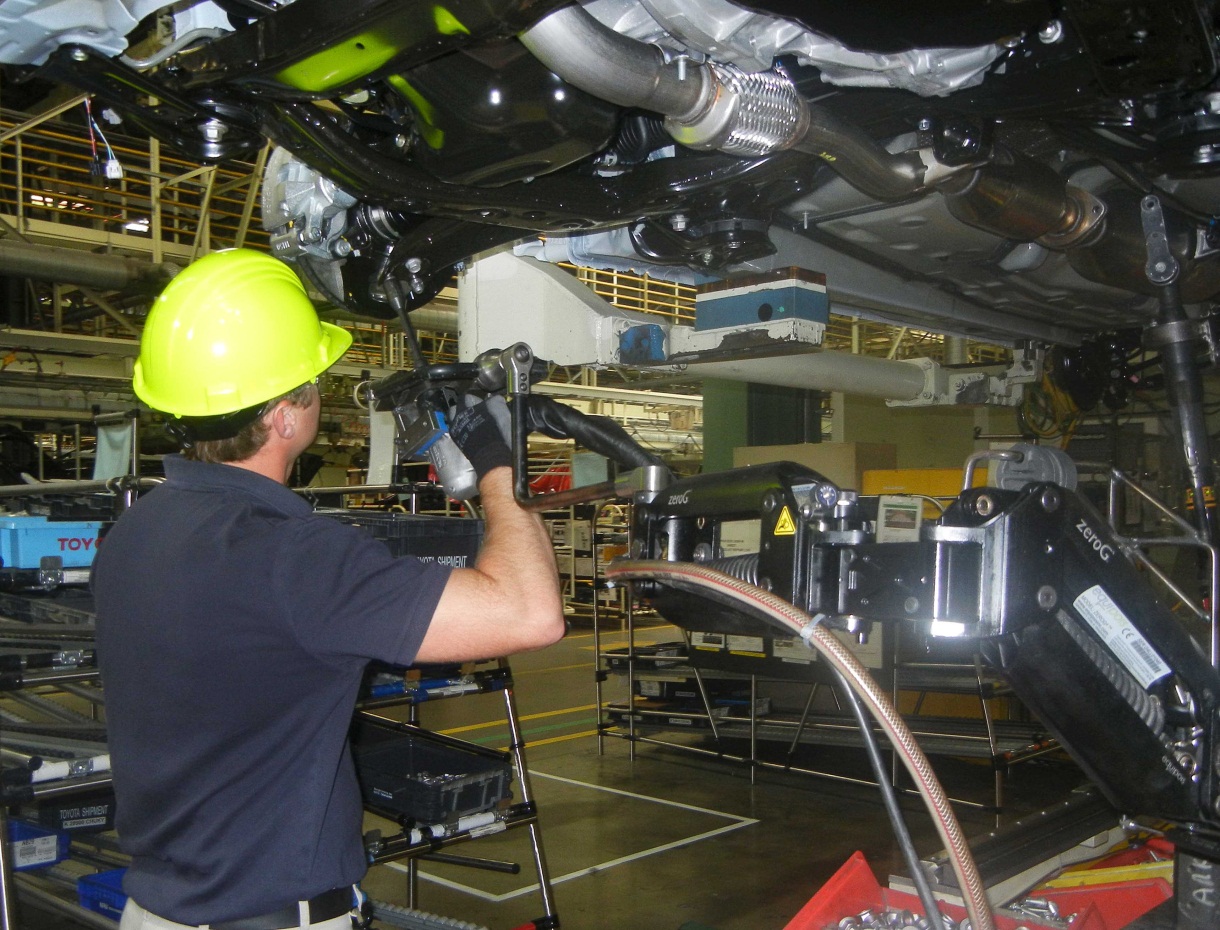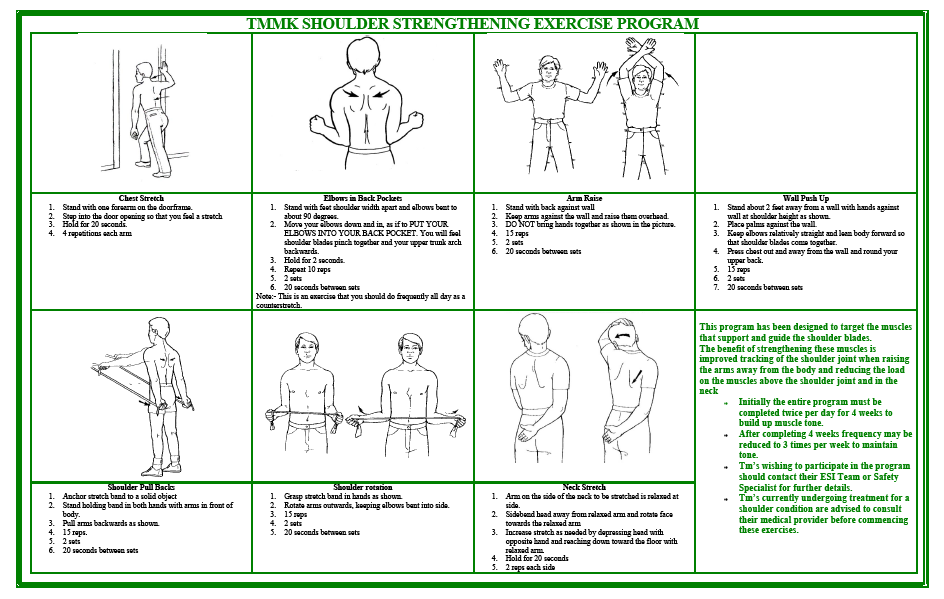Details of Interventions
Att K Details of Intervention.docx
Interventions to Reduce Shoulder MSDs in Overhead Assembly
Details of Interventions
OMB: 0920-0964
ATTACHMENT K
Details of Interventions
Tool Support (TS) Intervention
TMMK has pilot tested an articulating tool support device (TS) as an engineering control to reduce muscular loading as a countermeasure for the problem of overhead work and its contribution to shoulder-related MSD symptoms. The TS includes an articulated arm with multiple spring-tensioned joints originating from a dolly mounted base that can be moved with the assembly line. The device enables workers to maneuver tools as if they are weightless, but without loss of range of motion. The TS unloads the mass of the tool from the employee, potentially saving the employee from 48 minutes of supporting a 4.5 lb load above shoulder height over the course of a two-hour work period. The TS device is not believed to change working posture or the duration of time the employee’s arm is held elevated (a hypothesis that will be tested in study phase I). It is, however, expected to reduce scapulohumeral shoulder muscle fatigue accumulated over the work shift. TMMK has found that the intervention is widely accepted by employees on the chassis assembly line and, based on a few anecdotal reports, has reduced shoulder symptoms and discomfort among these employees.
The tool support contains a gimbal mount for a pistol grip nut running torque tool that is suspended at the end of the articulating arm. Adjustment of spring tensions are “tuned” to the mass of the tool supported. See Figure 1.

Figure 1. Tool support intervention.
Exercise Intervention
TMMK has previously pilot tested a “shoulder school” exercise program (E), developed and administered by a physical therapist, to condition the musculature of the employee’s shoulder complex and improve their musculoskeletal responses to overhead work. This program is similar in design to therapeutic exercise programs designed to modify motion and muscle activation abnormalities that are believed to be pervasive amongst those whose occupation requires significant exposure to humeral elevation and overhead work (Wang et al., 1999; Bang and Deyle, 2000; Ludewig and Borstad, 2003). The general strategies of these programs include: (1) strengthening of serratus anterior and the rotator cuff musculature; (2) enhancing normal patterns of scapulohumeral motion that reduce activation of upper trapezius, and (3) stretching to reduce “tightness” (shortness) in pectoralis minor and the posterior capsule of the glenohumeral joint. The “shoulder school” program was evaluated by Toyota in a quasi-experimental pilot test with six employees over a four week time period. Four of the six participants realized appreciable gains in functional capacity in four weeks. During that period study participants reported an 83% reduction in ratings of discomfort and the percentage of work shifts in which these employees reported experiencing no shoulder discomfort or fatigue increased from 53% to 92% (Burton and Jones, unpublished internal report).
Table 1 lists the specific exercises in the shoulder exercise program.
Table 1. Summary of Relevant Exercise Programs for Occupational Shoulder Pain. (Shown with representative studies of preventive exercise programs for shoulder pain/symptoms.)
Target joint, muscle, or movement |
L.L. Anderson et al. (2010) |
C.H. Anderson et al (2011)
|
Bang and Deyle (2000) |
Ludewig (2003) |
Borstad et al (2009) |
Camargo et al (2009) |
McClure et al (2004) |
Burton and Jones Toyota -** Unpublished |
Stretch of Posterior capsule |
|
|
Cross body adduction of humerus; passively increase stretch with opposite arm |
Cross body adduction of humerus; passively increase stretch with opposite arm |
Cross body adduction of humerus; passively increase stretch with opposite arm |
Cross body adduction of humerus; passively increase stretch with opposite arm |
Cross body adduction of humerus; passively increase stretch with opposite arm |
|
Stretch of Pectoralis minor |
|
|
Forearm on a wall, lean inward |
Hand on walls of a corner of a room or doorway, lean inward |
Hand on walls of a corner of a room or doorway, lean inward |
Hand on walls of a corner of a room or doorway, lean inward |
|
Forearm on a doorframe, lean inward |
Stretch of Rotator cuff |
|
|
|
|
|
|
Hold towel behind back, use other arm to pull towel up the back |
|
Stretch of Upper trapezius |
|
|
|
|
Seated, lean head left, drop forward and rotate chin to the right. Increase stretch passively using other hand. |
Seated, lean head left, drop forward and rotate chin to the right. Increase stretch passively using other hand. |
|
Standing, lean head left, drop forward and rotate chin to the right. Increase stretch passively using other hand. |
Selective Inhibition of Upper trapezius |
|
|
|
Relaxation of upper trapezius when elevating humerus overhead |
|
|
|
|
Strengthening Serratus anterior |
|
Push-up plus (modified) |
Elbow push up plus |
Lying scapular press with dumbells |
Push-up plus |
Seated push up plus with band |
|
Wall push up |
Strengthening Rotator cuff (external rotation) |
|
|
Horizontal extension with external rotation (with bands) |
External rotation with bands Upper arm at side and upper arm abducted |
External rotation with bands |
External rotation with band |
|
External rotation with bands |
Strengthening lower and upper trapezius - scapular retraction |
Shoulder shrugs (dumbbell) |
|
Standing rowing with band |
|
|
Standing rowing with bands |
Shoulder pull backs with bands |
Shoulder pull backs with bands |
Strengthening lower trapezius - scapular depression |
|
Seated press-up |
Seated press up |
|
|
|
|
Elbows in back pockets |
Strengthening Abduction (glenohumeral) |
Lateral raises (dumbbell)
Reverse flies (dumbbell) |
|
Scaption with band |
|
|
Abduction with band (scaption) |
|
|
Strengthening Flexion (glenohumeral) |
Front raises - shoulder flexion (dumbbell) |
|
Shoulder flexion (elevation) with band |
|
|
|
|
|

| File Type | application/vnd.openxmlformats-officedocument.wordprocessingml.document |
| Author | Lowe, Brian D. |
| File Modified | 0000-00-00 |
| File Created | 2021-01-24 |
© 2026 OMB.report | Privacy Policy